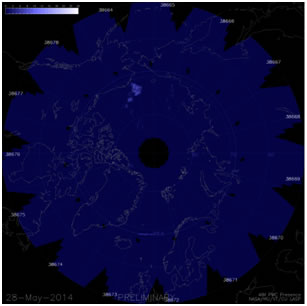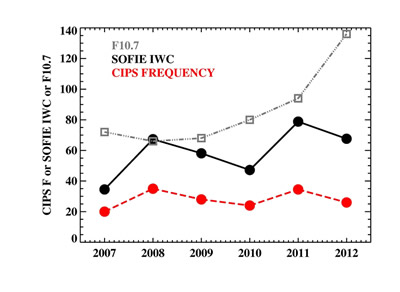|
STATUS:
06.01.2014
Spacecraft Status
On April 30th, the AIM spacecraft went into contingency mode due to a loadshed event. This occurred after the spacecraft had been commanded to an alternative control mode prior to the lunar eclipse that took place on April 29th. The spacecraft operations returned the spacecraft to normal operations on May 3rd. However, GATS reported that the SOFIE instrument seed did not occur properly. Following a detailed analysis of the problem, the ops team performed the recovery and SOFIE was back in operations on May 22nd.
The spacecraft and instruments are fully functional and performing well.
Instrument Status
CIPS: The CIPS instrument continues to perform well, with no health issues. The large negative beta angles continue to result in false cloud detections at high solar zenith angles, but this affects only a small fraction of the data near the terminator on the ascending node. The 2014 Northern Hemisphere PMC season is well under way. The CIPS daily daisy of 24 May shows our first clouds of the season. This is a fairly normal start; previous seasons have had CIPS start dates from 15-27 May, with four other seasons having CIPS start dates from 24-27 May. The image here is the most recent daily daisy, which is from 28 May. It shows a bright patch of clouds north of Alaska, with fainter clouds to the west. This sparse cloud distribution is typical of early season images.

SOFIE: SOFIE data was used in a recent publication [Siskind et al., 2013] to evaluate the relative roles of solar forcing, teleconnections from the stratosphere, and rocket exhaust on Northern Hemispheric PMCs. The Figure below shows year to year variability in SOFIE ice water content (IWC, g/km2) that is consistent with the AIM/CIPS instrument but that does not seem to follow the expected decrease with the rise of Solar Cycle 24. Rather the factor of 2 jump in IWC from 2007 to 2008 is now understood to be reflective of much colder conditions in the winter stratosphere in July 2008 relative to 2007. This teleconnection from the winter stratosphere to the summer mesopause is the result of planetary wave activity and concomitant effects on gravity wave propagation to the mesosphere. The second local maximum in IWC occurred in 2011. For this year, the stratosphere was in a neutral dynamical condition; rather the IWC increase has been linked with exhaust from STS 135, launched on July 8, 2011. These results add new complexity to our understanding of mesospheric weather and the year-to-year variability in PMCs.

click to enlarge
|
